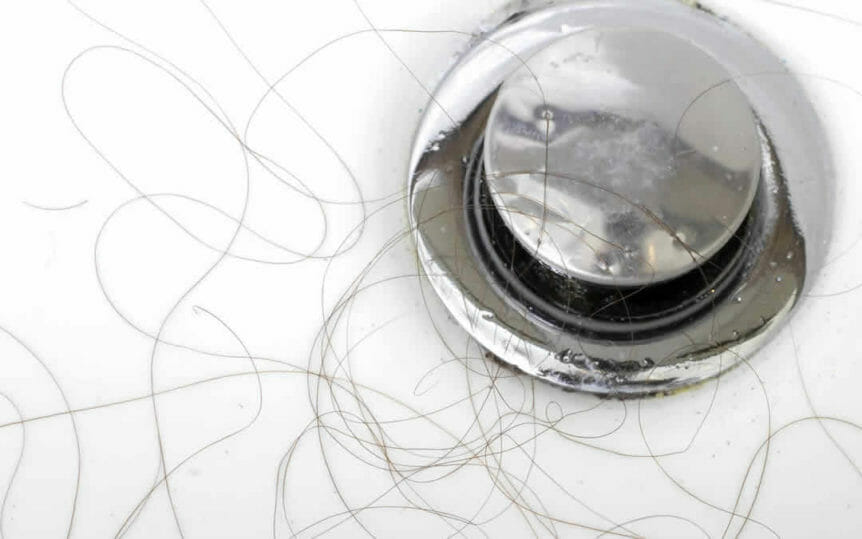
Clogged Drains Can Back Up All Your Plumbing – Get Help Now!
If you are a woman, know a woman, are married to a woman or just have even heard of woman, chances are you know what goes down after they wash their hair in the shower (literally!). If you’re a guy, it’s pretty much the same story. Hair accumulates in the drain pipe as more and more goes slipping down the drain, and next thing you know, your feet are sitting in murky water.
It can be a pretty icky situation, since hair can sit in the drain pipe for a long time before it’s cleaned out and accumulate skin particles, soap scum, hard minerals from the water, oils, and other things that use the hair as a base to sit in. It stinks. It looks gross. It clogs your pipes quickly. But it’s not anything that can’t be handled when done right.
We talked to Joe Bany, senior operations manager at John Moore, about the source of the problem, solutions for the average Joe, what the experts can do to help, and how to prevent clogs from happening any further. Read on for the inside scoop on what’s really going on under your feet!
The Root of the Problem
According to Bany, hair that accumulates in the drain is the main cause for shower drain clogs, on top of soap scum and hard minerals in the water. Typically these clogs are a combination of hair and soap that has clung together, blocking the flow of water down the drain.
“If you have hard water, which most people in Houston do, it’ll form hard crystals around the drain and it will actually take your pipe size from a standard 2-inch drain and slowly build mountains around the inside and slowly collapse the size of the hole,” Bany said. “And then as you wash your hair and shave, your hair falls out and just gets hung up in the drain along with it.”
Unclogging Your Shower Drain, for Dummies
So can you do? Once you have a clog, it can be pretty easy to notice that there is something in there. Although clogs are a pain, they aren’t always impossible to take care of on your own. In fact, most homeowners find that certain simple steps will take care of most of their issues.
Shower drain stoppages are common because the drains are literally building up every time you take a shower – soap scum, hair, oil, dead skin- it’s not necessarily something you’ll be eager to deal with. But the reality is, these things are flowing down your drain all the time, and they will eventually build up to the point where they can clog drains. We don’t recommend using chemicals on clogs that reappear in the same location over and over. This means you have a bigger problem and need a plumber to help solve the problem. When using chemicals we recommend Professional Strength Plumbers Formula 5 for normal stoppages and Plumbers Formula 6 for regular drain maintenance. We also recommend these commonly used methods for the do-it-yourselfer:
Coat Hanger– Use a screwdriver to remove any drain covers. Shine a flashlight into the drain. You might be able to see a wad of hair or other blockage that is clogging the drain. Insert a straightened wire coat hanger and try to fish out whatever is clogging the drain. This will work for minor clogs that aren’t too deep.
Baking Soda and Vinegar– If you can’t see a clog, you can always try using white vinegar and baking soda to try and flush it out. This takes a bit more time but is effective in flushing out and unclogging drains because it helps break up the material that’s causing the clog. We recommend 3/4 cups of baking soda followed by the same amount of vinegar. Then, cover the drain after pouring in the solution, which will isolate the clog and keeping the solution from flowing out.
When to Call the Pros
You’ve tried and tried again, and still nothing, even with Formula 5? It means you have a bigger problem than you think. It’s time to call in professionals to get the job done. Sometime it may not be just a normal stoppage– it can be something a bigger that requires professional grade work, equipment, and experience.
“The equipment is better when professionals do the work,” Bany said. “After inspecting, I would auger your drain. For the bathtub, we would take the overflow plate off and run a machine down through the top side of the tub to get down the drain where you can actually get all the hair out. Sometimes, on a tub, there are stoppers- everyone’s should come out. If you unscrew it and lift it, hair should come out. That’s one of the first things that you could do as a homeowner. Go in there with tweezers, a screwdriver, or a coat hanger and try to dig that hair out. It’s not easy. Women have really long hair. You’re sitting there looking down the drain and you might only see about half an inch of it when it’s actually a foot long.”
In the master shower, disassembling the drain might be required to use a bigger snake to try to break up some of that calcium buildup, and then eventually pull the hair out.
More severe instances would depend on the age of the home, if the house is settled, or if the pipes are broken.
“It gets into foundation issues. This is something you see on 10, 20-year-old homes that have settled a bit. It’s put pressure on a pipe or a pipe is broken, or a tree interferes. A tree can grow under the house and roots have gotten into the line. Those are the bigger things that your Plumbers Formula 5 or 6 liquid (sold only by John Moore Services) can’t take care of. That’s when you know you need to bring a professional out there to run a camera and see what’s really going on.”
You Can Prevent Severe Drain Clogs
It’s inevitable. Hair will come off you and your family’s heads until the earth turns to dust. It happens and will always happen. But you can still prevent major clogs from happening by simply reducing the amount of hair that actually finds its way down the drain.
According to Bany, the first thing to know is that you need to maintain your drain. You can do that with John Moore Services’ exclusive product,Plumber’s Formula 5 or the newest liquid drain maintainer, Plumber’s Formula 6. Both are designed to eat hair and soap scum which will help clear the path.
“There are some products you can buy that allow you to actually take your tub or shower drain plug out and cover it with a catcher,” Bany said. “It’s like a little strainer which catches all the hair. When you’re done showering, you just pull it right out and it brings the hair with it.”
Also, a shower drain strainer is about five inches around and five across, and it fits perfectly with your shower drain and won’t let the hair through. These things won’t stop every single hair, but they will definitely prevent major amounts from accumulating which will help prevent future clogs.
As we always say, it’s better safe than sorry, so make sure you take the proper, safe steps to take care your shower drain clogs. Call us at John Moore for more information and to get a plumbing expert at your door in no time.
